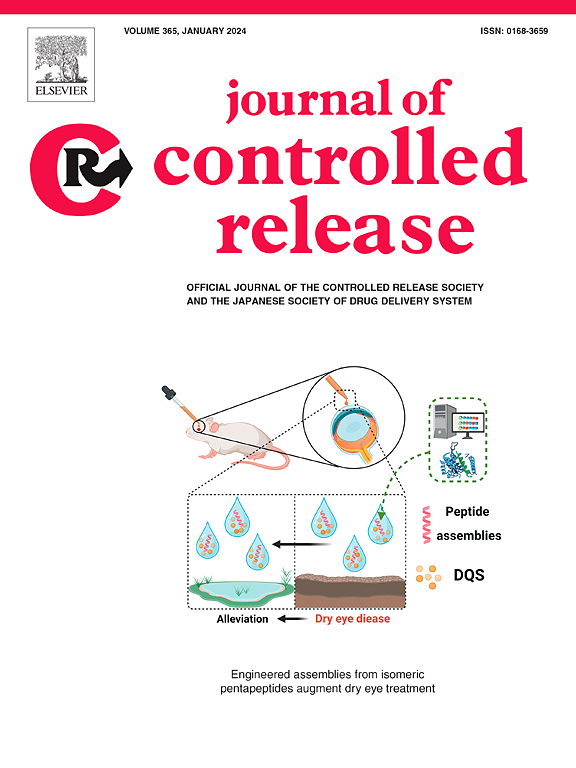Lipopeptide-mediated delivery of CRISPR/Cas9 ribonucleoprotein complexes for gene editing and correction
IF 10.5
1区 医学
Q1 CHEMISTRY, MULTIDISCIPLINARY
引用次数: 0
Abstract
CRISPR/Cas gene editing is a highly promising technology for the treatment and even potential cure of genetic diseases. One of the major challenges for its therapeutic use is finding safe and effective vehicles for intracellular delivery of the CRISPR/Cas9 ribonucleoprotein (RNP) complex. In this study, we tested and characterized a series of novel fatty acid-modified versions of a previously reported Cas9 RNP carrier, consisting of a complex of the cell-penetrating peptide (CPP) LAH5 with Cas9 RNP and homology-directed DNA repair templates. Comparative experiments demonstrated that RNP/peptide nanocomplexes showed various improvements depending on the type of fatty acid modification. These improvements included enhanced stability in serum, improved membrane disruption capability and increased transfection efficacy. Cas9 RNP/oleic acid LAH5 peptide nanocomplexes showed the overall best performance for both gene editing and correction. Moreover, Cas9 RNP/oleic acid LAH5 nanocomplexes significantly protected the Cas9 protein cargo from enzymatic protease digestion. In addition, in vivo testing demonstrated successful gene editing after intramuscular administration. Despite the inherent barriers of the tightly organized muscle tissues, we achieved approximately 10 % gene editing in the skeletal muscle tissues when targeting the CAG-tdTomato locus in the transgenic Ai9 Cre-LoxP reporter mouse strain and 7 % gene editing when targeting the Ccr5 gene, without any observable short-term toxicity. In conclusion, the oleic acid-modified LAH5 peptide is an effective delivery platform for direct Cas9/RNP delivery, and holds great potential for the development of new CRISPR/Cas9-based therapeutic applications for the treatment of genetic diseases.

脂肽介导的CRISPR/Cas9核糖核蛋白复合物的基因编辑和校正
CRISPR/Cas基因编辑是一项非常有前途的技术,可以治疗甚至治愈遗传性疾病。其治疗用途的主要挑战之一是寻找安全有效的细胞内递送CRISPR/Cas9核糖核蛋白(RNP)复合物的载体。在这项研究中,我们测试并表征了一系列先前报道的Cas9 RNP载体的新型脂肪酸修饰版本,该载体由细胞穿透肽(CPP) LAH5与Cas9 RNP和同源定向DNA修复模板的复合物组成。对比实验表明,RNP/肽纳米复合物根据脂肪酸修饰的类型表现出不同的改善。这些改进包括提高血清稳定性,改善膜破坏能力和提高转染效率。Cas9 RNP/油酸LAH5肽纳米复合物在基因编辑和校正方面均表现出最佳的综合性能。此外,Cas9 RNP/油酸LAH5纳米复合物显著保护Cas9蛋白货物免受酶促蛋白酶消化。此外,体内试验表明肌内给药后基因编辑成功。尽管紧密组织的肌肉组织存在固有的障碍,我们在针对转基因Ai9 Cre-LoxP报告小鼠菌株中的CAG-tdTomato位点时,在骨骼肌组织中实现了大约10% %的基因编辑,在针对Ccr5基因时实现了7% %的基因编辑,没有任何可观察到的短期毒性。综上所述,油酸修饰的LAH5肽是Cas9/RNP直接传递的有效传递平台,在开发新的基于CRISPR/Cas9的治疗应用方面具有很大的潜力,可用于遗传性疾病的治疗。
本文章由计算机程序翻译,如有差异,请以英文原文为准。
求助全文
约1分钟内获得全文
求助全文
来源期刊

Journal of Controlled Release
医学-化学综合
CiteScore
18.50
自引率
5.60%
发文量
700
审稿时长
39 days
期刊介绍:
The Journal of Controlled Release (JCR) proudly serves as the Official Journal of the Controlled Release Society and the Japan Society of Drug Delivery System.
Dedicated to the broad field of delivery science and technology, JCR publishes high-quality research articles covering drug delivery systems and all facets of formulations. This includes the physicochemical and biological properties of drugs, design and characterization of dosage forms, release mechanisms, in vivo testing, and formulation research and development across pharmaceutical, diagnostic, agricultural, environmental, cosmetic, and food industries.
Priority is given to manuscripts that contribute to the fundamental understanding of principles or demonstrate the advantages of novel technologies in terms of safety and efficacy over current clinical standards. JCR strives to be a leading platform for advancements in delivery science and technology.
 求助内容:
求助内容: 应助结果提醒方式:
应助结果提醒方式:


